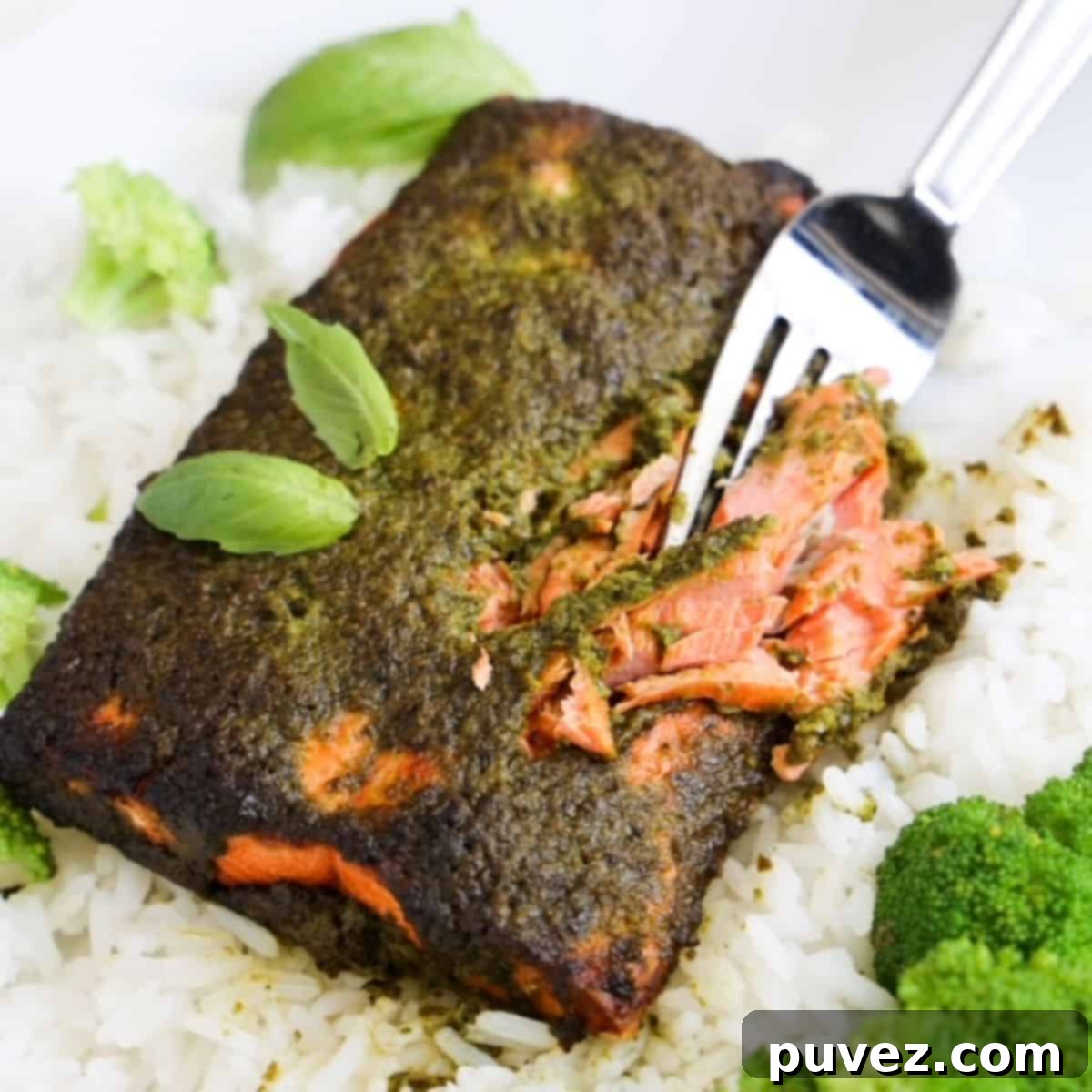Effortless & Delicious: How to Cook Frozen Salmon in an Air Fryer with Pesto
You’ll never believe how incredibly easy it is to make frozen salmon in an air fryer! Transform a busy weeknight into a culinary success with a tasty, healthy dinner ready in just 15 minutes. This simple recipe demystifies cooking salmon straight from the freezer, delivering flaky, flavorful results every time.
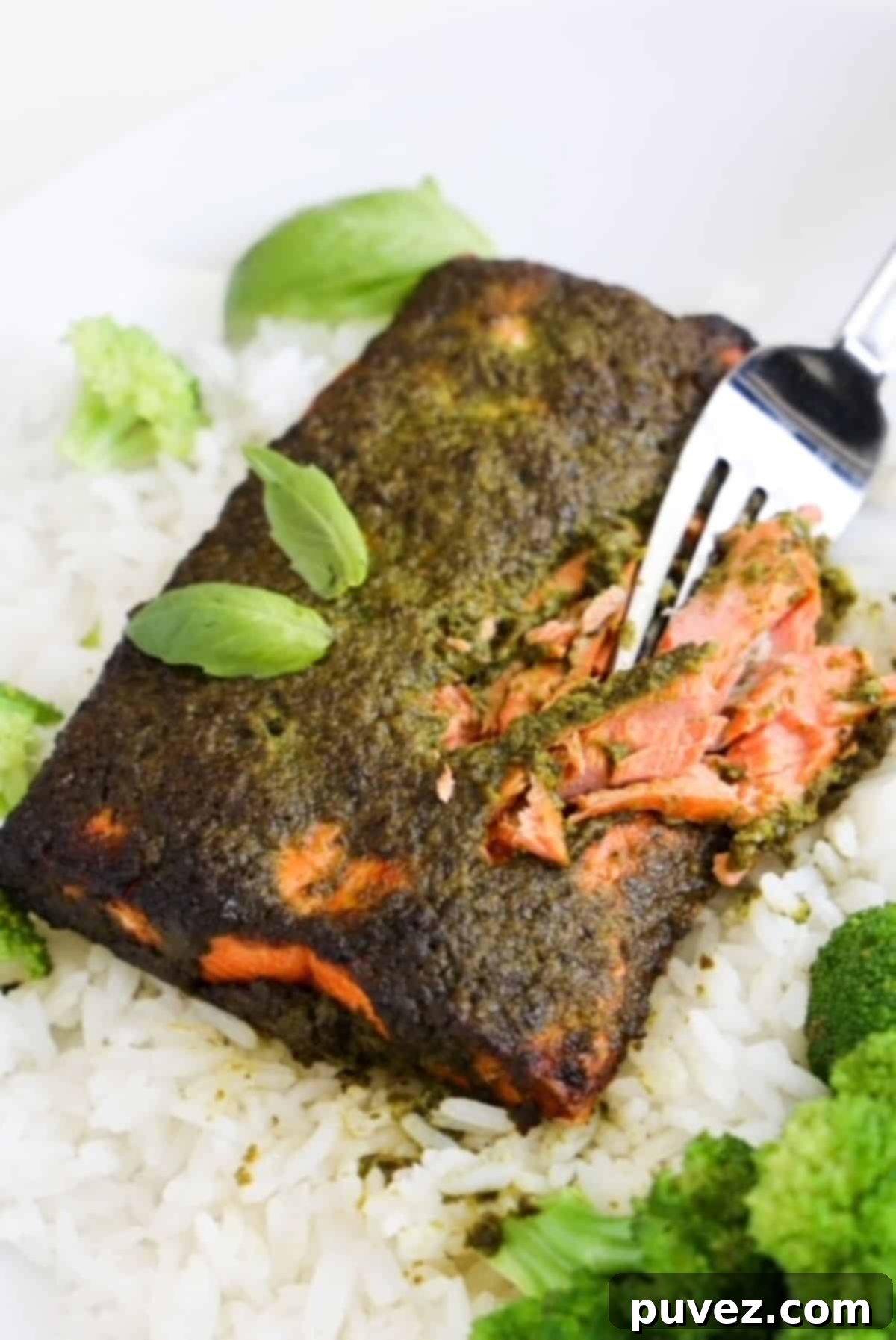
Even as a dietitian, keenly aware of the immense nutritional benefits of eating salmon, I’ve often struggled to find ways to cook it that are both delicious and don’t demand extensive meal planning. The idea of preparing a healthy fish dinner sometimes feels daunting, especially when fresh ingredients aren’t readily available or when time is short.
That’s precisely why, if I’m not poaching salmon for a specific recipe, my go-to method is always the air fryer! This versatile appliance has revolutionized how I approach quick and healthy meals.
Imagine my excitement when I discovered the game-changing secret: you can cook frozen salmon directly in an air fryer! This simple revelation has become my ultimate cooking hack. The trick is straightforward: slightly reduce the cooking temperature and extend the cooking time by a few minutes compared to fresh or thawed salmon. That’s all it takes to achieve perfectly cooked, moist salmon every time.
To ensure this recipe is consistently delicious, whether you’re using wild-caught or farm-raised salmon, I incorporate a generous layer of pesto on top of each fillet. The pesto not only infuses the salmon with incredible flavor but also helps to lock in moisture, preventing it from drying out. The result is a tender, flaky salmon with a vibrant, herbaceous crust that will tantalize your taste buds. You truly have to taste it to believe how good it is!
Why This Air Fryer Frozen Salmon Recipe Will Become Your New Favorite
This air fryer frozen salmon recipe isn’t just a meal; it’s a solution for busy weeknights, a boost for your health, and a delight for your palate. Here’s why you’ll find yourself reaching for this recipe again and again:
- Effortless & Exceptionally Delicious: Say goodbye to complicated cooking methods and lengthy prep times. This recipe requires minimal effort and delivers maximum flavor. It’s the simplest way to get a restaurant-quality salmon dish on your table without the fuss. Pair it with a quick side of rice, angel hair pasta, a simple steamed veggie, or even atop a fresh salad, and you have a well-rounded, complete meal in minutes.
- Only 2 Core Ingredients: That’s right, just frozen salmon and pesto! If you’re feeling ambitious and prefer to make your own pesto, you’ll need a few additional fresh ingredients like basil, olive oil, garlic, and Parmesan cheese. But for ultimate convenience, a good quality store-bought pesto works wonders.
- Ready in Just 15 Minutes: In today’s fast-paced world, time is precious. The absolute best part of this recipe (besides the amazing taste, of course!) is that it’s ready in a mere 15 minutes. This makes it an ideal solution for those hectic weeknights when you need a nutritious meal fast.
- Celebrates Simple, Pure Flavors: I recently had a conversation with a seasoned fisherman, and we both agreed: the best way to prepare fresh fish is with simple, high-quality seasoning. This recipe embraces that philosophy, allowing the natural goodness of salmon to shine through, beautifully complemented by the rich, aromatic pesto.
- A Powerhouse of Protein & Omega-3 Fatty Acids: Salmon is renowned for its incredible nutritional profile. It’s an excellent source of lean protein, essential for muscle repair and satiety, and it’s packed with heart-healthy Omega-3 fatty acids. Incorporating this recipe into your routine makes it easier to meet the daily recommended fish intake, supporting brain health, reducing inflammation, and promoting overall well-being.
Dietitian Tip: Making Fish a Family Favorite
It’s a common challenge, but meeting the recommended goal of eating two servings of fish per week can be surprisingly difficult, especially when you’re cooking for a family with varied palates or picky eaters. It’s important to remember that this is a general health recommendation for individuals of all ages and body sizes, and finding palatable ways to incorporate fish is key.
From my personal experience, salmon, with its distinct flavor profile, can be one of the trickiest fish to prepare in a universally appealing way. As a dietitian and a mom, I’ve been on a mission to crack the code – to discover a salmon preparation method that most, if not all, family members genuinely enjoy. It’s not always easy, but the nutritional benefits are well worth the effort.
After years of trying various recipes, I can confidently share a success story. My oldest child, almost 16 now, has always been a good sport about eating salmon, but it wasn’t her favorite. However, after trying this air fryer salmon recipe with pesto, her feedback was enthusiastic: “If you make it just like this, I’d eat it every day… with the pesto.” This endorsement truly highlights the power of this simple yet flavorful preparation. It transformed a “good for me” food into a “want to eat” food!
My point here is to never give up on introducing healthy foods. If one method of preparing fish doesn’t quite hit the mark, try another! Culinary exploration is part of the journey. And always remember the widely accepted guideline that it can take anywhere from 12 to 15 exposures for a new food to be truly accepted and enjoyed by children. So keep experimenting, and this air fryer pesto salmon might just be the winner for your family too!
Essential Ingredients for Your Air Fryer Salmon
This recipe shines in its simplicity, relying on just two key ingredients. Quality matters, so here’s a closer look at what you’ll need:
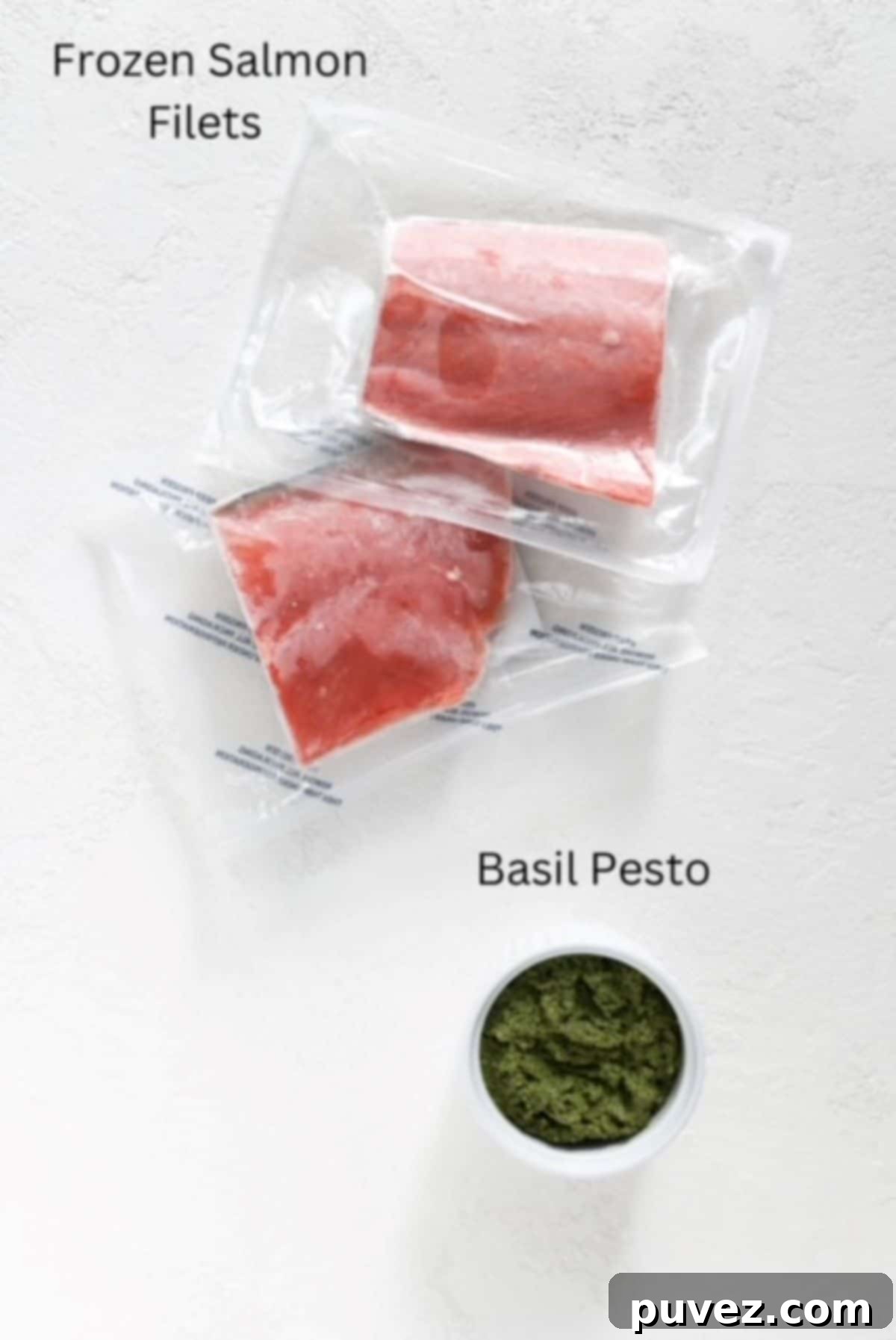
- Frozen Salmon Filets: You can use either wild-caught or farm-raised Atlantic salmon, depending on your preference and availability. Both varieties work beautifully in this recipe. Salmon is not only high in protein, making it excellent for satiety and muscle health, but it’s also an exceptional source of beneficial omega-3 fatty acids. These healthy fats are crucial for heart health, brain function, and reducing inflammation. There’s no need to seek out skinless fillets; the skin helps protect the fish from drying out and can easily be removed after cooking if desired. Look for individually vacuum-sealed portions for convenience and freshness.
- Pesto: This vibrant green sauce is the secret weapon in this recipe. Whether you opt for a high-quality store-bought pesto or choose to whip up one of my homemade recipes, like Pistachio Pesto or Pesto with Walnuts, it serves multiple critical roles. First, the oil and moisture in the pesto create a protective layer, preventing the salmon from drying out during the intense heat of the air fryer. Second, it infuses the fish with incredible flavor – a savory, herbaceous, and slightly tangy note that perfectly complements the rich taste of salmon. This recipe calls for three-quarters of a cup of pesto, which is equivalent to 6 ounces (remember, 2 ounces typically equals one quarter of a cup).
Step-by-Step: How to Cook Frozen Salmon in an Air Fryer
Cooking frozen salmon in your air fryer is surprisingly simple and yields fantastic results. Here’s a detailed summary of the easy steps. For the complete list of ingredients and full, printable instructions, please scroll down to the recipe card.
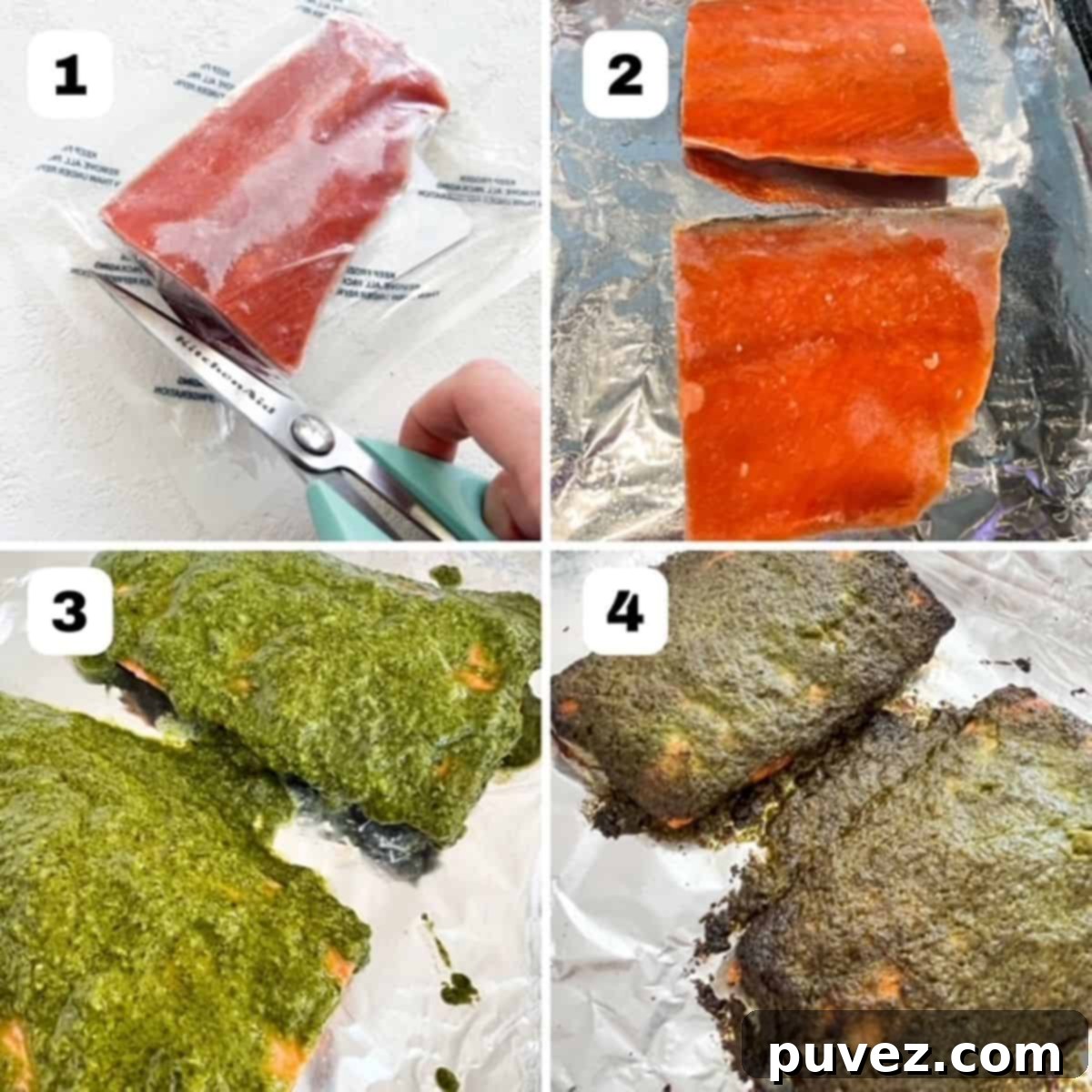
- Preheat Your Air Fryer: For the best and most consistent results, always start by preheating your air fryer. Set it to 375 degrees Fahrenheit (190°C) for about 2-3 minutes. This ensures the cooking environment is at the right temperature from the start.
- Prepare the Salmon: Carefully remove the frozen salmon fillets from their individual packaging. It’s crucial that no plastic or wrapping remains on the fish. Line the bottom of your air fryer basket with a piece of aluminum foil or parchment paper. This prevents sticking and makes cleanup a breeze. If using foil, you might want to lightly coat it with cooking spray or a thin layer of avocado oil.
- Initial Air Frying: Place the frozen salmon fillets, skin side down (if they have skin), in a single layer on the prepared foil in the air fryer basket. Ensure there’s a little space between each fillet for even air circulation. Insert the basket into the preheated air fryer and air fry the salmon for 7 minutes. This initial cooking phase helps to partially thaw the fish and begin the cooking process.
- Add the Pesto: After 7 minutes, carefully pull out the air fryer basket. The salmon will still be partially frozen but should be firm enough to handle. Now, generously spread a layer of pesto (approximately 3-4 tablespoons per fillet) over the top of each salmon fillet. The pesto will melt and adhere beautifully as it cooks. Return the basket with the pesto-topped salmon to the air fryer.
- Finish Cooking & Check Doneness: Continue cooking in the air fryer for another 6 minutes. At this point, it’s essential to check the internal temperature of the thickest part of the fillet using a reliable digital meat thermometer. Salmon is generally considered done when it reaches an internal temperature between 125°F (52°C) and 145°F (63°C). It should be opaque throughout and flake easily with a fork. If it’s not quite done, air fry for additional 1-2 minute increments until it reaches the desired temperature. Remember, it will continue to cook slightly once removed from the air fryer.
Helpful Tips for Perfect Air Fryer Frozen Salmon
Achieving perfectly cooked, juicy frozen salmon in your air fryer is incredibly simple, especially with these insider tips:
- Always Preheat Your Air Fryer: While you might skip preheating for some air fryer recipes, it’s absolutely crucial for salmon. Preheating ensures that the air fryer basket is at the correct temperature from the moment the salmon goes in, promoting even cooking and a beautiful crust. This prevents the salmon from sitting in a warming appliance, which can lead to uneven cooking.
- Adjust Cook Time as Needed: The exact cooking time can vary based on several factors: the specific model and wattage of your air fryer, the size and thickness of your salmon fillets, and your desired level of doneness. Thicker fillets will naturally take longer. Always use the recommended times as a guideline and adjust as necessary.
- Foil vs. Parchment Paper: Aluminum foil is generally recommended for lining the air fryer basket as it can withstand higher temperatures. If you prefer to use parchment paper, ensure you use an air fryer-specific liner or a piece that is just slightly larger than your salmon fillet(s). This prevents the excess parchment from flying up and potentially burning or interfering with the air circulation.
- Prevent Sticking: To ensure your delicious salmon doesn’t stick to the foil or parchment paper, lightly coat it with cooking spray or use a basting brush to spread a thin layer of high-heat oil (like avocado oil) on the surface before placing the fish. This simple step makes removal effortless.
- Invest in a Digital Meat Thermometer: This is your best friend for perfectly cooked proteins. Insert the probe into the thickest part of the salmon fillet. For safe and optimal results, aim for an internal temperature between 125°F (52°C) and 145°F (63°C).
- Account for Carryover Cooking: Fish continues to cook for a few minutes after it’s removed from the heat. Pull your salmon out of the air fryer when it reaches the lower end of the desired temperature range (around 125-135°F), then let it rest for 2-5 minutes. This allows the heat to redistribute and the temperature to rise slightly, resulting in incredibly moist salmon.
- The Fork Test: If you don’t have a digital food thermometer, don’t worry! You can still test for doneness. Gently insert a fork into the thickest part of the salmon. If it separates easily into flakes, it’s ready!
- Avoid Overcooking: Overcooked salmon is the cardinal sin of fish preparation. It loses its moisture quickly and becomes dry, tough, and chewy, diminishing its delicate flavor. Always err on the side of slightly undercooking and letting it rest.
- Quality Frozen Seafood Matters: When purchasing frozen salmon, always inspect the packaging. Do not buy frozen seafood if its package is open, torn, or crushed on the edges, as this can indicate temperature abuse or contamination.
- Check for Firmness: Similarly, avoid packages where the “frozen” fish flesh is not hard. The fish should be solid and unbendable when fully frozen, indicating proper storage.
- Consult Your Air Fryer Manual: Every air fryer is slightly different. For the best and safest results, always refer to your specific manufacturer’s instructions for cooking times and temperatures, especially when cooking from frozen.
Delicious Ways to Serve Your Air-Fried Pesto Salmon
This air-fried pesto salmon is incredibly versatile and pairs beautifully with a wide array of sides. Here are some of my favorite ways to enjoy it:
- Pesto Pasta Perfection: Elevate a simple pasta dish into a gourmet meal. Serve your flaky salmon over a bed of al dente pasta noodles, perhaps tossed with a little extra pesto, wilted spinach or broccoli, and a refreshing squeeze of fresh lemon juice. For an even heartier meal, you can use this salmon in place of cooked chicken in my popular Pesto with Tortellini recipe, creating a delightful seafood pasta.
- A Flavorful Salad Topping: The rich, savory notes of the pesto salmon make it an ideal topping for various salads. It adds a substantial protein boost and incredible flavor. Try flaking it over a hearty Tuscan kale salad, or swap it in for the chicken in this healthy Caesar salad recipe for a satisfying and light lunch or dinner. It’s also fantastic on a simple mixed greens salad with a light vinaigrette.
- Classic & Comforting Sides: Sometimes, the best way to enjoy perfectly cooked salmon is with straightforward, comforting accompaniments. Serve your pesto salmon alongside a fluffy bed of rice (brown or white), quinoa, or a simple orzo dish like my easy orzo with broccoli. Roasted vegetables are another excellent choice; think tender roasted asparagus, carrots, or even bell peppers, which beautifully complement the salmon’s flavors and create a balanced meal.
- Breakfast or Brunch Delight: Don’t limit salmon to dinner! Flaked leftover pesto salmon can be a fantastic addition to a breakfast scramble, an omelet, or even on top of avocado toast for a sophisticated brunch.
More Easy Air Fryer & Dinner Recipes
If you loved the convenience and flavor of this air fryer frozen salmon, you’ll definitely want to explore these other simple and delicious recipes, many of which also leverage the magic of the air fryer:
- Air Fryer Sweet Potato Fries
- Air Fryer Sweet Potato Chunks
- Air Fryer Broccoli with Parmesan
- Crispy Air Fryer Kale Chips
- Simple Air Fryer Beet Chips
- 15-Minute Air Fryer BBQ Chicken
- Easy Ground Turkey Tacos
- Easy Lemon Pepper Chicken Marinade
Did you make frozen salmon in your air fryer and absolutely love it? I’m always eager to hear about your culinary successes! Please leave a 5-star review or a comment below to share your experience.
Don’t forget to follow me on Instagram @carrots.and.cookies for more easy, delicious recipes that even picky teens will actually eat! 😉
Frequently Asked Questions About Air Frying Frozen Salmon
Absolutely, yes! One of the greatest advantages of using an air fryer is its ability to cook many foods, including fish, directly from a frozen state without prior thawing. This convenience is a huge time-saver and makes healthy meals more accessible. When cooking frozen fish, it generally takes a little longer than fresh or thawed fish. Also, depending on the type of seasoning or sauce you’re using, you might need to slightly reduce the air fryer temperature (by about 25 degrees Fahrenheit) to prevent the topping from burning before the fish is fully cooked through. For this pesto salmon recipe, a slight temperature adjustment and split cooking time works perfectly.
Cooking salmon from frozen can be done successfully using a few methods. The most popular and efficient ways include baking it in the oven or, as demonstrated in this recipe, air frying it. Both methods will require a longer cooking time compared to cooking fresh or thawed salmon. Regardless of the method you choose, it’s critically important to remove all packaging, including any vacuum seals or plastic wrap, before you begin cooking the frozen fish. Always cook until the internal temperature reaches a safe level for consumption (125-145°F).
In my extensive experience, cooking frozen salmon fillets in an air fryer at 375 degrees Fahrenheit typically takes between 13 to 18 minutes. The exact cooking time can vary based on several factors, such as the thickness and size of your salmon fillets (e.g., Wild Coho Salmon vs. Wild Sockeye Salmon can differ), and the specific model and wattage of your air fryer. To ensure perfect doneness, I recommend checking the internal temperature with a digital food thermometer at the 13-minute mark. If it hasn’t reached the desired 125-145°F, continue cooking in additional 2-minute increments until it’s done. This method prevents overcooking and ensures a flaky, moist result.
Most individual portions of frozen salmon come vacuum-sealed in plastic. To safely remove the salmon, start by using kitchen scissors or a sharp knife to carefully cut just above the widest end of the salmon fillet, making a small opening. This allows air to enter the package, breaking the vacuum seal. Once air is introduced, you can more easily use the scissors to cut across the top edge of the entire fillet’s packaging, allowing the frozen piece of salmon to slide out freely. Always be cautious when using sharp tools.
Leftover cooked salmon is a culinary gem! Store any extra cooked salmon refrigerated in an airtight container for up to two days. While you can gently reheat it (preferably in the air fryer at a low temperature to prevent drying), I often find it’s even better enjoyed cold or at room temperature. It’s fantastic flaked into a fresh green salad, mixed into a wrap or sandwich, stirred into cream cheese for a flavorful bagel spread, or even transformed into delicious salmon cakes. The possibilities are endless, and it makes for a quick and healthy addition to future meals. Yum!
For this particular recipe, we cook frozen salmon in an air fryer at 375 degrees Fahrenheit (190°C). This temperature ensures that the salmon cooks through evenly without drying out, especially with the protective layer of pesto. If you were cooking plain frozen salmon without a sauce, you might consider a slightly higher temperature like 380-400°F, but for a sauced fillet, 375°F is ideal to prevent burning the topping while allowing the fish to cook.
For this recipe, where pesto is applied to the top, flipping the salmon is generally not necessary. The air fryer’s circulating hot air cooks the fish evenly from all sides. Keeping the skin side down on the foil helps the fillet maintain its shape and moisture, while the pesto on top creates a flavorful crust. If you were cooking unseasoned salmon and wanted a crispier bottom, you might consider a gentle flip halfway through, but it’s often not required for a great result.
More Easy Dinner Recipes to Simplify Your Week
- 15-Minute Air Fryer BBQ Chicken
- Easy Ground Turkey Tacos
- Easy Lemon Pepper Chicken Marinade
- 15-Minute Pesto with Tortellini
Did you make frozen salmon in your air fryer and love it? I’d love to hear how it went! Please leave a 5-star review or comment below to let me know
Don’t forget to follow me on Instagram @carrots.and.cookies for more easy recipes that teens will actually eat 😉
📖 Recipe
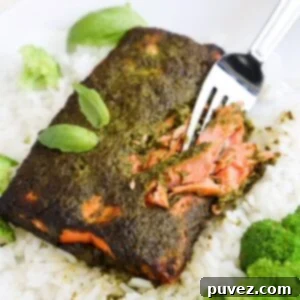
Frozen Salmon in Air Fryer with Pesto
Kristi
Pin Recipe
Equipment
-
1 Air Fryer
Ingredients
- 16 oz Salmon filets 4, four-ounce frozen salmon filets
- ¾ cup Pesto
Instructions
-
Preheat your air fryer at 375 degrees Fahrenheit (190°C) for about two minutes.
-
Remove the packaging from frozen salmon fillets completely and line your air fryer basket with a piece of aluminum foil for easy cleanup.
-
Place the frozen salmon fillets, skin side down, in a single layer on the foil-lined air fryer basket, ensuring some space between each fillet.
-
Air fry the frozen salmon fillets at 375 degrees Fahrenheit (190°C) for 7 minutes. Carefully open the air fryer, pull out the basket, and spread a generous layer (about 3-4 tablespoons per fillet) of pesto on each salmon fillet. Return the basket to the air fryer. Continue to air fry for another 6 minutes. Check the internal temperature with an instant-read digital food thermometer, aiming for between 125-145 degrees Fahrenheit (52-63°C). If needed, air fry for an additional 1-2 minutes until the desired temperature is reached.
Notes
- Time-Saving Alternative: If you’re really short on time, you can place the pesto on the frozen salmon fillets from the start and then air fry for a continuous 14 minutes. The pesto might get slightly more caramelized or “burnt” this way, but it will still taste absolutely amazing and save you a step.
- Salmon Variety: I’ve successfully made this recipe with both wild Sockeye salmon and wild Coho salmon, and both varieties yielded fantastic results. Feel free to use your preferred type of frozen salmon.
- Air Fryer Variations: Keep in mind that air fryer cooking times can vary depending on your specific air fryer model, its wattage, and the size and thickness of your individual frozen salmon fillets. Always use the provided times as a guideline and adjust as necessary.
- Always Use a Thermometer: For the safest and most perfectly cooked salmon, a digital food thermometer is highly recommended. Insert it into the thickest part of the fillet to check the internal temperature.
- Optimal Doneness: Remove the salmon from the air fryer when its internal temperature reaches between 125°F (52°C) and 145°F (63°C). The fish will continue to cook slightly with residual heat (carryover cooking) during a short resting period.
- No Thermometer? Use the Fork Test: If you don’t have a digital food thermometer handy, you can still tell when the salmon is done. Gently flake the thickest part of the fillet with a fork. If it separates easily into opaque flakes, it’s ready to enjoy.
- Beware of Overcooking: The biggest mistake when cooking salmon is overcooking it. Overcooked salmon quickly becomes dry, tough, and chewy, losing its delicious texture and flavor. It’s better to slightly undercook and let it rest, allowing carryover cooking to finish the job.
- Selecting Quality Frozen Seafood: Always choose frozen seafood with care. Avoid purchasing frozen seafood if its packaging is open, torn, or crushed at the edges, as this can indicate damage or improper handling.
- Frozen Fish Should Be Hard: Ensure that the “frozen” fish flesh in the package is hard and firm. The fish should not be flexible or bendable, as this suggests it may have partially thawed and refrozen, compromising quality and safety.
- Parchment Paper Precaution: If you opt for parchment paper instead of aluminum foil, make sure to use a piece that is cut to the size of the salmon fillet(s) or an air fryer-specific liner. This helps prevent the outer edges of any excess parchment paper from burning or interfering with air circulation as the salmon cooks.
Nutrition
Calories: 341kcal
Carbohydrates: 4g
Protein: 25g
Fat: 24g
Saturated Fat: 4g
Polyunsaturated Fat: 3g
Monounsaturated Fat: 2g
Cholesterol: 66mg
Sodium: 485mg
Potassium: 556mg
Fiber: 1g
Sugar: 1g
Vitamin A: 983IU
Calcium: 88mg
Iron: 1mg
Tried this recipe?Let us know how it was!
